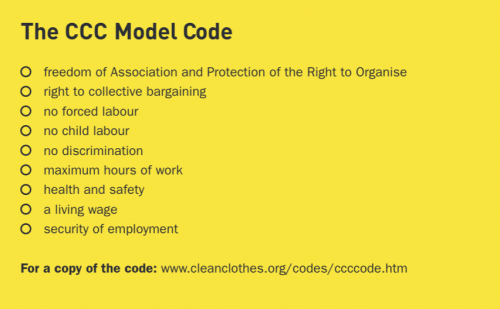Frequently asked questions (FAQs)
What are the current problems in fashion industry?
- Poverty wages
-
Tens of millions of people work in the global garment and sportswear industry. The vast majority of them work extremely long hours, for very little pay. Sweatshop wages can be found from Asia to Eastern Europe to Latin America, with major brands admitting that literally zero of their workers earn a living wage.
-
- Unsafe workplaces
-
Fashion's search for the lowest costs comes at a high price: the health and sometimes even lives of workers. Thousands have died in factory fires and collapses. And other dangers lurk, like the use of hazardous chemicals or sandblasting. Then there's the noise, heat and bad ventilation.
-
- Bad contracts, no job security
-
Subcontracting work is the norm in the industry, often several layers deep. That means workers don't get a regular contract, but a series of short-term contracts or not even that. Forced overtime is common. Home workers and other vulnerable groups are even more at risk, as are workers in special "Free Trade Zones" or the informal sector.
-
- Unclear supply chains
-
The garment and footwear industry stretches around the world. Clothes and shoes sold in stores in the US, Canada, Europe, and other parts of the world typically travel across the globe. A T-shirt label might say “Made in China,” but in which of the country’s thousands of factories was this garment made? And under what conditions for workers?
-
- Waste and pollution
-
The garment industry is one of the largest carbon polluters on planet Earth, and one of the greatest producers of waste. Three out of five of the 100 billion garments made in 2018 will end up in landfill within a year. Toxic chemicals land in the environment and worker communities, and the production of cotton uses up vast amounts of water.
-
- Worker rights violations
-
Factory workers who manage to organise often face repression, or are fired. Fashion brands sometimes try to deny their responsibility by hiding behind the fact they are outsourcing their production. However, international standards make clear that brands must make sure that all labour rights need to be respected and full remedy needs to be given when violations occur.
-
- Gender discrimination
-
Eighty percent of the estimated 40-60 million garment workers are female, and this is not a coincidence. In an industry notorious for less-than-decent working conditions, low wages, forced overtime and unsafe conditions, women are often deprived of maternity leave, child care and safe travel to work. These structural violations are made worse by gender based violence.
-
- Exploitation of migrants
-
Hundreds of thousands of migrants are employed throughout the garment and textile supply chains around the world. They are subjected to many of the same abuses that local workers encounter. However, these abuses are compounded by the specific contexts in which migrant workers work.
-
- Union busting
-
Most production takes place in countries with the lowest wages, but also with the worst record on union freedom. Major garment producing countries, such as China, Bangladesh, Indonesia, The Philippines, Turkey, Vietnam belong to the worst countries for workers to organise in.
-
- Weak, voluntary efforts by brands
-
Fashion brands have lots of nice policies listed on their websites. The problem is, most of these are non-binding and voluntary. Factory inspections are often announced before-hand, and are done by auditing firms who are paid by the brands, without any involvement of workers.
-
- Covid crisis
-
The COVID-19 pandemic is touching lives all over the planet, but is hitting garment workers in particular. They risk their health working in crowded factories without sufficient protection and risk their livelihood if they are sent home without pay. Brands and retailers need to act to protect the workers who have enabled their profits in the past.
-
- Climate change
-
Garment production is a major contributor to climate change and garment workers are being severely affected. Brands must urgently address the need for industry wide solutions to social and environmental crises concurrently. You can’t have one without the other.
-
How much money do workers earn?
In an estimate of a US$130 pair of shoes made in Indonesia, just $0.70 (that's 0.5% of the total retail cost) goes to production workers' wages. In contrast, the company makes a profit of $17 (or 13%). Labour costs can vary based on many factors, but total wages are almost never more than 5% of the total retail price. This is true even for low-price items such as T-shirts offered by budget brands. So even in an extreme scenario, if a worker's wages were to double the cost was passed along directly to consumers, the item would cost only 5% more: your €130 pair of shoes would cost just €136.5. Alternatively, companies could absorb this negligible increase themselves and the consumer price would remain the same.
Read more about our living wage campaign and learn how we fight for better wages.
Isn't that because the cost of living is so much cheaper in garment-producing countries?
The cost of living in garment-producing countries is indeed cheaper than in the global north, but garment workers are still not paid a wage that covers their basic needs, such as food, shelter, clothing and education.
This video illustrates how poorly workers are living and why do we need a living wage.
Which are the good and ethical brands?
We know that you would like a list of "good" brands, so you know where to shop (and where to stop!). The answer is unfortunately not as clear as a "good" and a "bad" list. The Clean Clothes Campaign exists to help empower garment workers on the ground to improve their conditions.
In other words: we choose not to operate as a consumer label that investigates everything there is to know about every brand. Instead, we focus on labour conditions and push for living wages, safer factories and innovative way to empower workers to fight for their rights.
Tips to recognize brands that do more on workers rights:
No brand is totally perfect. There is no magic answer. However, some brands are doing more to help workers than others. We would like consumers to buy from companies that take steps to implement the Full Package Approach, in order to encourage them to keep doing it!
Clean Clothes Campaign expects companies to have:
- A comprehensive code of conduct that addresses all International Labour Organisations norms, such as the right to join a union and the right to a written contract.
- Take serious steps to implement this code. Companies should critically monitor the way they buy their own clothing and to take measures to work towards the payment of a living wage.
- Undertake credible stakeholder participation.
- Actively support freedom of association and collective bargaining.

If you want to find out if your favourite brand is doing this already, you can look on their websites or request more information.

